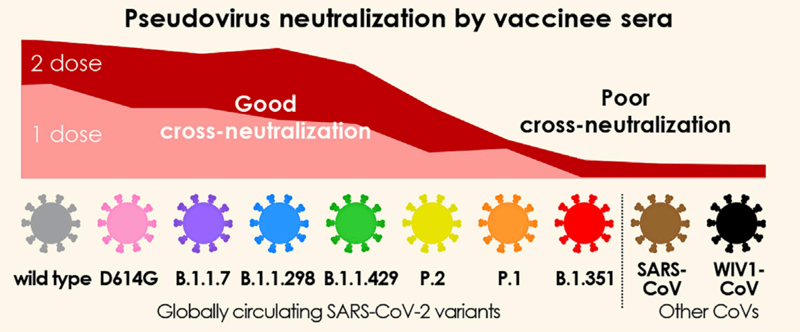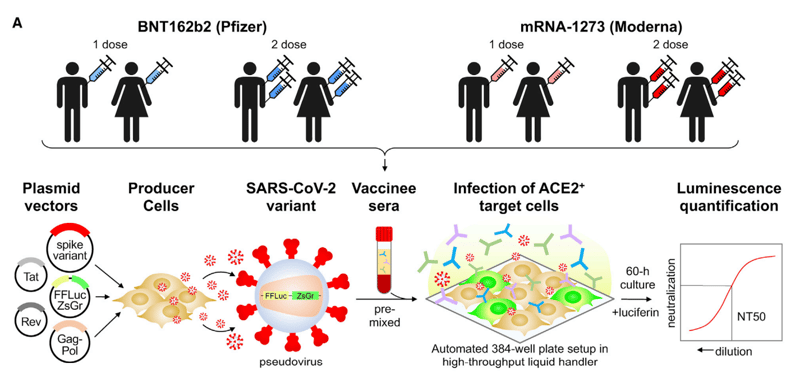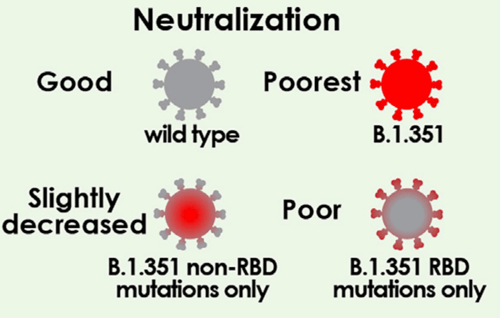Over the past several months, we’ve seen the emergence of several SARS-CoV-2 variants coincide with increased vaccination efforts. So, how effective are the current vaccines against the variants?
Alejandro Balazs, a Group Leader at the Ragon Institute of MGH, MIT, and Harvard, and his lab found that the neutralization effectiveness of current vaccines differed depending on the variants (Garcia-Beltran et al., 2021). Antibodies from individuals who received both doses of the Moderna or Pfizer vaccine could neutralize many variants, including the B.1.1.7 (Alpha variant), B1.1.298, and B.1.429 (Epsilon), nearly as well as they could for the wild-type. However, variants such as the P.1 (Gamma variant) and the B.1.351 (Beta variant) were much less effectively neutralized. The B.1.617.2 (Delta variant) was not tested at the time of this study.
 |
| Figure 1: Neutralization levels against spike pseudovirus decreases depending on the variant. The lowest levels of cross-neutralization occurs in the P.1 and B.1.351 variants tested. Image from Garcia-Beltran et al., 2021 with permission. |
The spike variant pseudovirus neutralization assay
Balazs’s lab, which studies immunity and the host-pathogen interface, previously developed a high-throughput neutralization assay to study the link between COVID-19 disease severity and the development of neutralizing antibody responses in patients. They were able to tweak this assay to study SARS-CoV-2 spike variants.
“We created a series of spike expressing plasmids which encode spikes found on all of the different circulating variants. This allowed us to create pseudoviruses that represent lineages and variants that are actually transmitting out in the world” says Balazs. “By combining those with [sera] we got from people that have been given the vaccine, we've been able to measure their relative ability to neutralize.”
 |
|
Figure 2: Sera used in the study came from individuals who received either one or two doses of the Pfizer or Modern vaccine. This sera was used in the high-throughput SARS-CoV-2 pseudovirus neutralization assay. Neutralization was quantified in terms of luminescence. Image from Garcia-Beltran et al., 2021 with permission. |
Mutations in the spike protein are one of the key drivers in determining whether the current vaccines are effective or not. This protein both elicits an immune response as the target of vaccines and allows the virus to gain entry into human cells via human ACE2 receptors. In their assay, the pseudoviruses express a luciferase reporter which is used as a readout for infection of ACE2-expressing target cells. Any neutralized pseudoviruses would be unable to get into the target cells and this can be detected via loss of luminescence.
B.1.351 variant neutralization escape
The lab saw that the B.1.351 variant was very resistant to vaccine serum responses. This result was similar to studies that used live virus (Cele et al., 2021). “We weren't completely shocked [with these results] because we were simulating the live virus experiment,” says Balazs. “But what was surprising was the extent to which the escape appeared to be happening.”
In their assay, the neutralization rates of B.1.351 pseudovirus was similar to that of pseudoviruses representing a bat-derived coronavirus and SARS-CoV. These two viruses are quite genetically distinct from SARS-CoV-2 and its variants. Yet, the B.1.351 variant, which has only 9 different mutations compared to the wild-type, escaped neutralization. “That degree of escape from a very small number of mutations was surprising,” says Balazs.
 |
| Figure 3: Neutralization outcomes of convalescent sera with various pseudotyped virus. Image from Garcia-Beltran et al., 2021 with permission. |
Difference in neutralization after one dose and two doses of the mRNA vaccines
While there have been many studies on the effectiveness of current vaccines against SARS-CoV-2 variants, this study was the first to compare so many different strains. It was also the first to perform neutralization studies after just the first vaccination and after both vaccinations. For the B.1.351 variant, a single vaccination didn’t result in any cross-neutralization. “In that context, what we showed was that the antibody responses are really not sufficient after one vaccine to neutralize the virus,” says Balazs, emphasizing the importance of the second vaccine dose in mounting a robust immune response.
The Balazs lab was quick to deposit their plasmids at Addgene to accelerate ongoing COVID-19 research. “I hope that by sharing the plasmids other scientists would be able to expand upon the work and continue to make contributions towards this COVID-19 pandemic,” says Balazs.
References and Resources
References
Cele S, Gazy I, Jackson L, Hwa S-H, Tegally H, Lustig G, Giandhari J, Pillay S, Wilkinson E, Naidoo Y, Karim F, Ganga Y, Khan K, Bernstein M, Balazs AB, Gosnell BI, Hanekom W, Moosa M-YS, Lessells RJ, de Oliveira T, Sigal A (2021) Escape of SARS-CoV-2 501Y.V2 from neutralization by convalescent plasma. Nature 593:142–146. https://doi.org/10.1038/s41586-021-03471-w
Garcia-Beltran WF, Lam EC, Astudillo MG, Yang D, Miller TE, Feldman J, Hauser BM, Caradonna TM, Clayton KL, Nitido AD, Murali MR, Alter G, Charles RC, Dighe A, Branda JA, Lennerz JK, Lingwood D, Schmidt AG, Iafrate AJ, Balazs AB (2021) COVID-19-neutralizing antibodies predict disease severity and survival. Cell 184:476-488.e11. https://doi.org/10.1016/j.cell.2020.12.015
Garcia-Beltran WF, Lam EC, St. Denis K, Nitido AD, Garcia ZH, Hauser BM, Feldman J, Pavlovic MN, Gregory DJ, Poznansky MC, Sigal A, Schmidt AG, Iafrate AJ, Naranbhai V, Balazs AB (2021) Multiple SARS-CoV-2 variants escape neutralization by vaccine-induced humoral immunity. Cell 184:2372-2383.e9. https://doi.org/10.1016/j.cell.2021.03.013
Additional resources on the Addgene blog
- Browse all COVID-19 related blog posts
- Learn more about pseudotyping
Resources on Addgene.org
- Find plasmids in Addgene's COVID-19 collection
- Find SARS-COV-2 pseudotype virus plasmids from Addgene
Topics: COVID-19







Leave a Comment